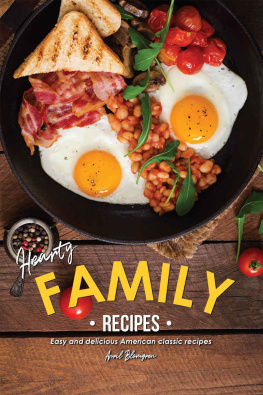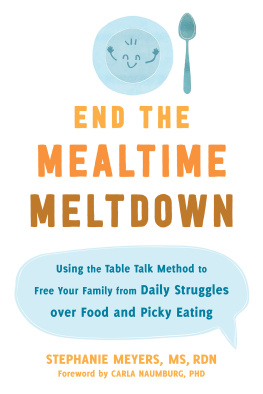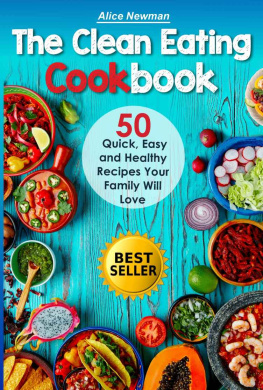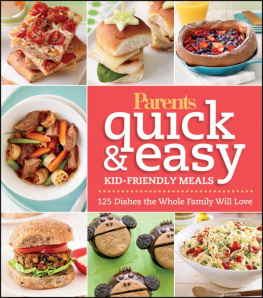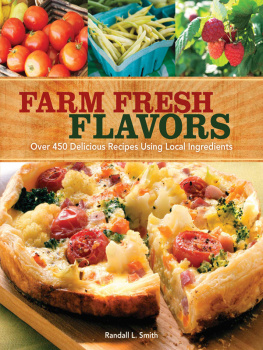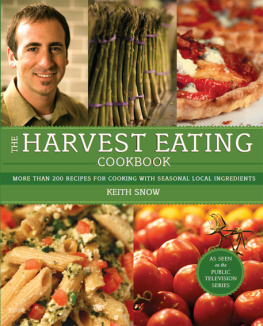Contents
Guide
Pagebreaks of the print version


PUBLISHED BY
Princeton Architectural Press
70 West 36th Street
New York, NY 10018
www.papress.com
2022 Julian C. E. Clauss-Ehlers
and Caroline S. Clauss-Ehlers
All rights reserved.
No part of this book may be used or reproduced in any manner without written permission from the publisher, except in the context of reviews.
Every reasonable attempt has been made to identify owners of copyright. Errors or omissions will be corrected in subsequent editions.
Editor: Jennifer Thompson
Designer: Benjamin English
Illustrator: Danielle Golinski
LIBRARY OF CONGRESS CATALOGING-IN-PUBLICATION DATA
NAMES: Clauss-Ehlers, Julian C. E., author. | Clauss-Ehlers, Caroline S., author.
TITLE: Eating together, being together : recipes, activities, and advice from a chef dad and psychologist mom / Julian C. E. Clauss-Ehlers, Caroline S. Clauss-Ehlers, PhD, ABPP.
DESCRIPTION: New York: Princeton Architectural Press, 2022. | Includes bibliographical references and index. | Summary: Recipes, essays, tips, and activities exploring how cooking and sharing meals helps to build healthy relationships among family and with food Provided by publisher. IDENTIFIERS: LCCN 2022013114 | ISBN 9781648961137 (hardcover) | ISBN 9781648962059 (epub) SUBJECTS: LCSH: Cooking. | Eating (Philosophy) | LCGFT: Cookbooks. CLASSIFICATION: LCC TX714 .C563 2022 | DDC 641.5dc23/eng/20220321
LC RECORD AVAILABLE AT
https://lccn.loc.gov/2022013114
The advice, tips, and suggestions in this book are not a substitute for medical or mental health advice; see your physician/pediatrician and/or a mental health professional if you have health and/or mental health related questions.
Please note that, where applicable, people in real-life examples have been de-identified.

CONTENTS
INTRODUCTION
Eating Mindfulness Having an
Having an Honest Food Conversation
T he idea for Eating Together, Being Together was developed long before our COVID-19 world made its appearance. It came out of our areas of expertise as a chef (Julian) and a psychologist (CC), but mostly from the experience of raising our three kids. Over the years, we saw how much we engage with one another when we share a meal as a family, and we learned from the time our kids were young that magical things happen for people around food: kids open up while they measure flour or mix batter; adults tell stories of their childhood while they eat a favorite family recipe; bad feelings are mitigated; memories are made.
In our respective workplaces, we have seen that its not always like this. When Julian volunteered with a program focused on teaching schoolkids about healthy foods, he saw that many of the students didnt know how to eat mindfully and werent familiar with the concept of healthy eating. In my work as a psychologist, Ive seen how parents, guardians, caregivers, and family members struggle to meet time demands, which often interfere with sitting down and having a meal together. Being married to a chef who works long hours, and being really unskilled at cooking myself, I can entirely relate to this reality.
Kids and parents are often busy and rush through meals, and older children may have their own schedules. Olliver, who is now six years old, would often have dinner with just me or the babysitter at 5 p.m. and be in bed by 7 p.m. Then his sisters and I would sit together and have dinner at 7:30 p.m. Julian would get home from work at 10 p.m. and have dinner by himself. Multiple lives, multiple meals, and multiple separations. But when we experienced quarantine, we were suddenly together for breakfast, lunch, and dinner. From one day to the next, we were literally having meals together all the time. This experience left us with a greater awareness of the value and benefits of family mealtime, and we know we are not alone.
We wrote Eating Together, Being Together because we wanted to share our unique insights as chef, psychologist, and parents. Trained in France, where healthy eating is part of the culture, Julian (British by birth) was surprised to learn that the culture of eating was very different in the United States. He saw that overly processed foods were often a go-to option for overworked, tired families (ours included) and aims to change this culture by instilling healthy eating habits in childhood that will continue throughout ones life. He wants to empower parents to support their kids in this journey.
For many years Ive worked as a psychologist with families that face multiple stressors in their daily lives. Through my own family life and clinical work, Ive seen the benefits of family members spending time cooking together and eating together. Mealtime is a way our families can connect to talk about the stress they face and brainstorm solutions. Families that have routines are more resilient, and sharing even one mealtime a day helps build that resilience. Also, as my daughters have moved into the teen years, Im grateful that they want to prepare delicious meals, helping me find a balance between work and other responsibilities. Did I mention I love food but am not good at cooking it?
The pandemic that began in 2020 raised unexpected challenges for family life. For working parents, the challenge was how to take care of children who were suddenly at home during the weekday, either in quarantine or attending school remotely, while simultaneously addressing work obligations. For parents with young children, this also meant finding a balance without the support of childcare or outside schooling. For parents of preteens or teens, this often meant watching the painful process of their adolescents anxiety unfold as they lost the option to be with friends, explore identity through peer connections, struggle with online learning, and try to manage concerns about the future. Many parents across the globe lost their jobs (Julian was unemployed for about eleven months), and quarantine stress was magnified by economic insecurity and uncertainty around when or if family members would be employed again. The overlay to this sharp disruption, and sense of loss, was the anxiety about COVID-19 itself and fears about who would get sick and who we might lose.
Our son, Olliver, who was four at the time, said, We all have to be human together. Being human together involved adjusting to this massive, overnight change in how we lived our lives and engaged in new and different ways with our community. We learned some revelatory things about being parents. Olliver was absolutely delighted to have us around. He started to talk so much that he graduated from speech therapy during the quarantine. Our daughters, Sabrina and Izzy, then fourteen and sixteen years old, talked about the dilemma so many teens were facing that involved the pros and cons of being at home versus losing time at school and with their peers.
And we liked being together with our kids and sharing daily meals. With a chefs scheduletwelve-hour days, six days a weekwe had never experienced that kind of togetherness during the course of our marriage. The entire family got involved with meal planning at various stages: from shopping, to prepping, to cooking, to setting the table, to finally sitting down to share the same meal at the same time. The tips and tools that follow in Eating Together, Being Together provide ways families can enjoy a meal that has been prepared by everyone for everyone and helps to make people appreciate the effort of cooking and the fun of cooking together. Family members can also feel proud about eating a meal that has been contributed to by many. All of this builds positive relationships for families while also encouraging healthy eating.


